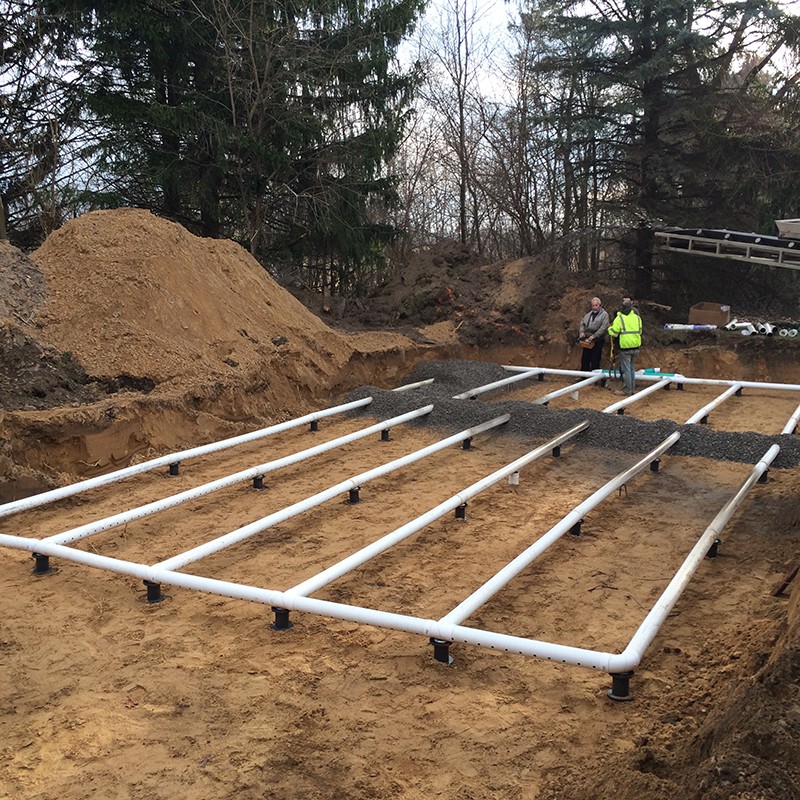Septic design in Shelburne Ontario plays a vital role in ensuring safe wastewater management and compliance with local regulations. This guide provides a clear and informed overview of how septic systems should be designed, reviewed, and implemented in Shelburne while meeting the highest standards for expertise, authority, and trust.
Understanding Septic Design in Shelburne
Septic design refers to creating an onsite sewage facility that properly treats household wastewater. In Shelburne, septic systems must follow Ontario Building Code Part 8, which mandates requirements for system sizing, soil evaluation, and environmental protection. Onsite sewage facilities serve properties not connected to municipal sewers. Such systems need proper design to avoid health risks and environmental damage.
Regulatory Landscape and Municipal Involvement
The County of Dufferin oversees building permits, and septic installations require approved septic design drawings. Installers must submit as‑built drawings and confirm the system matches the permit before occupancy is granted. Municipal approval leads into the formal permit process affecting any structure or septic installation.
Who Should Design Your Septic System
Design must be performed by someone qualified. Homeowners may design systems for their own use if they possess the knowledge. Otherwise, a registered designer holding a BCIN or a licensed engineer must complete the design. Hiring a professional ensures accuracy in soil assessments, drainage evaluations, and regulatory compliance.
Local Expertise: Headwaters Construction
Headwaters Construction offers professional septic design services from Caledon across Dufferin County, including Shelburne. Their team includes engineers with more than 25 years of experience and capability in residential, commercial, and agricultural projects. They manage site evaluation, permitting, eco‑conscious design, and system construction. Their focus on sustainable outcomes and clear communication supports seamless project execution.
Local Expertise: Elmid Design Inc
Elmid Design Inc supports septic design across Ontario. Their team of experienced septic designers delivers comprehensive services that align with provincial regulations and performance standards. Their expertise enhances credibility and ensures high expertise, authority, and trust for septic design projects.
Environmental Importance of Proper Septic Systems
Septic systems must safely protect groundwater and surrounding ecosystems. Onsite sewage facilities operate on the property that generates wastewater, and poor design or maintenance can lead to contamination. Ontario regulations require systems to be sized and located based on soil type and site limitations. High performance systems use conventional septic tanks and subsurface infiltration or advanced technologies when needed.
Typical Septic Design Process
Septic design starts with a site evaluation, including soil and groundwater assessments and measuring required fixture load. Designers size the septic tank and field, submit plans to municipal authorities, and work through permit approval. After installation, an as‑built drawing is produced and submitted to building services to reach occupancy.
Ensuring Compliance and Longevity
Compliance involves meeting building code standards, obtaining permits, and ensuring that installation matches the design. Following design, installers must produce an as‑built drawing. Final grading must be done, and the system needs completion of landscaping or sod after backfill.
Choosing Your Septic Service Provider
Select a provider based on credentials, experience, and local knowledge. Headwaters Construction brings engineering expertise and Dufferin region familiarity. Elmid Design Inc provides trusted septic design across Ontario. Ask for proof of design experience, past project examples, and clarity about regulatory handling.

Common Septic Design Errors in Shelburne Projects
Many property owners overlook important site factors before beginning septic installation. A common mistake includes underestimating the importance of soil analysis and drainage rates. Without proper site evaluation, systems risk failing early. Errors also occur when designs are submitted without meeting local bylaw setbacks or when unauthorized modifications happen during construction. These issues often delay permit approvals or trigger costly redesigns. Oversights during construction inspections and incomplete as-built drawings create further compliance issues. Local professionals can prevent these errors with accurate measurements, experienced design input, and familiarity with the Shelburne building department requirements.
Role of Soil and Drainage in System Performance
Soil type affects how wastewater gets absorbed and treated underground. Clay-heavy soil limits drainage and may cause backflow or saturation. Sandy soil allows rapid infiltration but may not provide enough natural filtration. In Shelburne, septic designers must assess soil by conducting percolation or soil tests, often required for permit approval. Drainage planning includes evaluating the slope, surface runoff, and any nearby wells or bodies of water. An ideal site balances absorption with filtration capacity to protect water sources and avoid surface pooling. Proper planning leads to better system longevity and fewer service problems.
Maintenance Expectations for Long-Term Success
A septic system needs regular maintenance to continue working safely and efficiently. Property owners in Shelburne should plan for tank pumping every few years, depending on the number of occupants and tank size. Failing to pump allows solids to enter the leaching bed, causing premature failure. Regular inspections catch early signs of blockage, damage, or infiltration. All plumbing fixtures must direct waste only into the septic system. Surface water should be directed away from the septic bed area. Designers often recommend maintenance plans tailored to the system’s capacity, household use, and environmental conditions.
Permits and Septic Inspections in Dufferin County
Building permits are required for all septic installations and replacements in Shelburne. The permit application must include a site plan, detailed septic design, and a soil report. Once the application is submitted to Dufferin County’s building department, the design is reviewed for code compliance. Before installation, inspections confirm the site conditions match the submitted plans. Inspectors may visit multiple times, including before backfilling the septic bed. Final approval only occurs after the system passes all inspections and an as-built drawing is filed. Any modifications must be resubmitted for approval to maintain compliance.
Key Differences Between New and Replacement Systems
Designing a septic system for a new build in Shelburne allows full customization based on lot layout and soil type. Designers can position tanks and fields for optimal performance. Replacement systems often face tighter constraints due to existing landscaping, structures, or previous system footprints. Engineers may need to modify designs to accommodate limited space or address legacy issues. In either case, designs must align with modern codes and health standards. Municipal staff treat both types with equal scrutiny, requiring detailed drawings, proper setbacks, and current soil evaluation before issuing a permit.
Costs and Budget Considerations
Septic design costs vary depending on property size, soil type, and system complexity. Basic designs for standard lots in Shelburne start at moderate pricing but increase for difficult soil or compact lot sizes. Additional engineering support or environmental mitigation raises design fees. Installation costs depend on excavation, tank materials, labor, and whether advanced treatment units are required. Homeowners should include the cost of permits, site inspections, and potential landscaping restoration in the total project budget. Proper design helps avoid expensive future corrections, ensuring the investment meets all code and environmental standards.
Why Choose Elmid Design Inc for Septic Projects
Elmid Design Inc holds a certificate of authorization from Professional Engineers Ontario, demonstrating a commitment to regulatory compliance and engineering quality. Their experience designing septic systems throughout Ontario allows them to adapt quickly to local soil conditions and municipal expectations. They offer full-service support including permit applications, soil testing coordination, and system layout. Their certified team ensures projects avoid delays, meet inspection benchmarks, and perform reliably over time. Elmid Design Inc adds professional assurance backed by engineering credentials that help owners achieve peace of mind from design through completion.
Seasonal Planning for Septic Installation
Septic installations in Shelburne follow seasonal cycles tied to soil conditions and permit processing timelines. Spring and early summer provide the most favorable ground conditions for excavation and inspection access. Frozen soil in late fall or winter makes installations more difficult and often delays projects. Permit approvals typically take several weeks, so planning should begin early to avoid construction bottlenecks. Designers and installers advise starting soil testing before the ground thaws to fast-track design completion. Aligning design, permit submission, and installation with weather forecasts improves overall efficiency and reduces unexpected costs.
Design Upgrades and Advanced Systems
Some properties in Shelburne may require advanced septic systems to meet modern performance standards or address difficult soil conditions. These systems include additional filtration, aerobic treatment, or pressurized distribution to enhance performance. While more expensive, they often become necessary when traditional systems cannot be approved due to shallow soils or high water tables. A licensed engineer or qualified designer evaluates whether a site justifies these upgrades. Modern systems often bring long-term benefits through better treatment efficiency and extended lifespan. Elmid Design Inc provides support in selecting and designing the right system upgrade.
How to Start Your Septic Design Today
Beginning a septic design project in Shelburne requires selecting a qualified professional and conducting a thorough site evaluation. Early planning ensures accurate permit submissions and reduces costly delays. Contacting experts like Elmid Design Inc or Headwaters Construction offers direct access to proven methods, engineering insight, and municipal familiarity. Their teams help guide the process from soil testing through final inspection. Homeowners should gather property documents, building plans, and location data to streamline design discussions. Taking the first step early helps align the project timeline with seasonal availability and permit approvals.
Integrating Septic Design with Site Planning
Septic design influences where homes, driveways, and landscaping can be placed. In Shelburne, designs must ensure that septic systems maintain required setbacks from wells, property lines, and watercourses. A poorly placed home can restrict where a septic bed may legally go, causing delays or requiring redesign. Smart planning begins with the septic layout before finalizing building footprints. Coordinating septic placement with topography, soil conditions, and access routes avoids major conflicts. Experienced design teams help optimize usable space while ensuring full code compliance. Elmid Design Inc often works directly with architects and builders to ensure system placement supports long-term property value.
Impact of Septic System Type on Property Value
A properly designed septic system can improve the resale value of rural properties in Shelburne by ensuring consistent performance and legal approval. Buyers and inspectors examine septic reports and designs during real estate transactions. A system backed by professional engineering, with clear as-built records and recent service logs, builds trust. Poor documentation or system age often leads to reduced offers or conditional agreements requiring upgrades. Modern systems that include extra treatment steps offer environmental appeal and longer service life, which attracts buyers seeking long-term value. Professional design adds credibility that carries over into resale negotiations.
Understanding Setbacks and Sizing
The Ontario Building Code requires specific distances between septic components and surrounding features such as property lines, buildings, and wells. These setbacks help prevent contamination and system failure. Sizing depends on the number of bedrooms, bathrooms, and water fixtures in the home. Shelburne’s building department enforces these rules strictly during permit reviews. Failure to meet sizing or setback rules can result in permit denial or costly redesigns. A licensed designer or engineer calculates system size using daily flow estimates and soil absorption rates. Elmid Design Inc prepares designs to ensure every detail aligns with regulations, preventing future issues.
How Rainwater and Landscaping Affect Septic Systems
Improper drainage near the septic bed can cause pooling, saturation, or even hydraulic overload. Gutters and downspouts should direct water away from the system area. Landscapes that slope toward the septic field increase the risk of flooding and reduce system efficiency. Trees planted too close can damage pipes or interfere with drainage. Designers consider these factors during site planning by evaluating slope, soil stability, and runoff patterns. Strategic grading helps protect system function and extend life span. In Shelburne, local inspections often evaluate drainage plans during the permit phase to avoid landscape-related performance issues later.
Common Misconceptions About Septic Systems
Some homeowners believe septic systems require little attention after installation, which leads to early failure. Another misconception is that all soil types can support standard leaching beds, but many sites in Shelburne require engineered alternatives. Some believe septic systems are temporary or secondary solutions, though they remain permanent infrastructure in non-sewered areas. Thinking municipal connections are always available also causes false expectations during land purchases. Qualified designers help dispel these myths and provide realistic long-term strategies. Choosing firms with engineering credentials such as Elmid Design Inc reduces risk and clears up confusion early in the process.
Importance of Recordkeeping and Design Documentation
Proper recordkeeping helps track inspection schedules, service history, and future upgrade needs. In Shelburne, the building department requires septic design drawings, soil evaluations, and final as-built plans to be kept on file. These documents support real estate transactions, future permit applications, or troubleshooting. Systems without paperwork often require new evaluations or replacements before resale. Design documentation prepared by engineers like Elmid Design Inc ensures technical accuracy and municipal acceptance. Maintaining clear records improves system maintenance and increases homeowner confidence that the installation meets safety, legal, and environmental requirements throughout the system’s operational life.
Frequently Asked Questions
What qualifications are required for a septic designer in Shelburne?
A septic designer must hold a valid BCIN or be a licensed professional engineer in Ontario. Homeowners may only design their own systems if they understand the code and procedures. Using a certified professional like Elmid Design Inc ensures full compliance and high design accuracy.
How long does it take to get a septic permit in Shelburne?
Permit approvals vary but generally take two to four weeks once the full application is submitted. Including a site plan, soil evaluation, and design drawings ensures quicker turnaround. Delays often happen when documents are missing or incorrectly prepared.
Are soil tests mandatory for septic design in Ontario?
Yes, the Ontario Building Code requires a site evaluation that includes soil testing to determine suitability for a septic system. Soil type and drainage rate influence the system type and size that may be approved. Skipping this step risks rejection during the review process.
Can I replace an old system without a new design?
Replacing a septic system usually requires updated design drawings that reflect current standards and site conditions. The new system must comply with modern code, and changes in lot layout or water usage may require different sizing or configuration.
Who inspects septic systems during construction?
Dufferin County’s building services department performs inspections at key points during construction, such as after excavation and before backfilling. These ensure that the system matches the approved design. A final inspection reviews installation and requires an accurate as-built drawing.
What happens if my septic system fails?
If a system fails due to age, design flaws, or damage, the owner must replace or repair it under current Ontario regulations. This includes submitting a new design for approval and undergoing inspection. Continued use of a failing system is illegal and hazardous.

Why Elmid Design Inc is the Trusted Choice for Septic Design in Ontario
Elmid Design Inc is a PEO-authorized engineering firm delivering expert septic design solutions across Ontario. With deep knowledge of Ontario Building Code and municipal processes, Elmid ensures every system is code-compliant, efficient, and built to last. Their team offers tailored support from soil analysis to permit approvals, making them the preferred partner for residential and commercial septic design in Shelburne and beyond.
Geographic Locations That We Service:
Our Licensed Professional Engineers specializing in Engineered Site Grading Plans offer the best-engineered site grading plan, lot grading and erosion plan, and drainage plan to obtain site plan approval and building permits in Ontario, including a wide range of municipalities. Each area boasts unique features and requirements, making our tailored approach essential for success.
Toronto and Surrounding Areas
In the vibrant heart of Ontario, we service Toronto (City of Toronto) and surrounding areas. Additionally, we cover Oshawa (City of Oshawa), Pickering (City of Pickering), and Clarington (Municipality of Clarington). Furthermore, our expertise extends to Ajax (Town of Ajax), Whitby (Town of Whitby), Brock (Township of Brock), Scugog (Township of Scugog), and Uxbridge (Township of Uxbridge).
Halton Region
Moving to the Halton Region, our services encompass Burlington (City of Burlington) and Halton Hills (Town of Halton Hills). Also included are Milton (Town of Milton) and Oakville (Town of Oakville).
Peel Region
In the Peel Region, we provide services in Brampton (City of Brampton), Mississauga (City of Mississauga), and Caledon (Town of Caledon).
York Region
Our services in the York Region cover Vaughan (City of Vaughan), Aurora (Town of Aurora), and East Gwillimbury (Town of East Gwillimbury). We also cater to Georgina (Town of Georgina), Markham (City of Markham), Newmarket (Town of Newmarket), Richmond Hill (City of Richmond Hill), Whitchurch-Stouffville (Town of Whitchurch-Stouffville), King (Township of King), and Bradford-West Gwillimbury (Town of Bradford-West Gwillimbury). Each municipality here offers a distinct setting, requiring our specialized approach.
Other Southern Ontario Cities and Towns
We also serve many other cities and towns in Southern Ontario. These include Hamilton (City of Hamilton), St. Catharines (City of St. Catharines), Niagara on the Lake (Town of Niagara on the Lake), Brant (County of Brant), Cambridge (City of Cambridge), Kitchener (City of Kitchener), Waterloo (City of Waterloo), and Woodstock (City of Woodstock). Furthermore, we operate in Guelph (City of Guelph), Centre Wellington (Township of Centre Wellington), Shelburne (Town of Shelburne), Orangeville (Town of Orangeville), New Tecumseth (Town of New Tecumseth), Essa (Town of Essa), Collingwood (Town of Collingwood), Wasaga Beach (Town of Wasaga Beach), Barrie (City of Barrie), Midland (Town of Midland), Orillia (City of Orillia), Ramara (Town of Ramara), Minden Hills (Town of Minden Hills), North Kawartha (Town of North Kawartha), Kawartha Lakes (City of Kawartha Lakes), Peterborough (City of Peterborough), Selwyn (Town of Selwyn), and Brighton (Municipality of Brighton).




